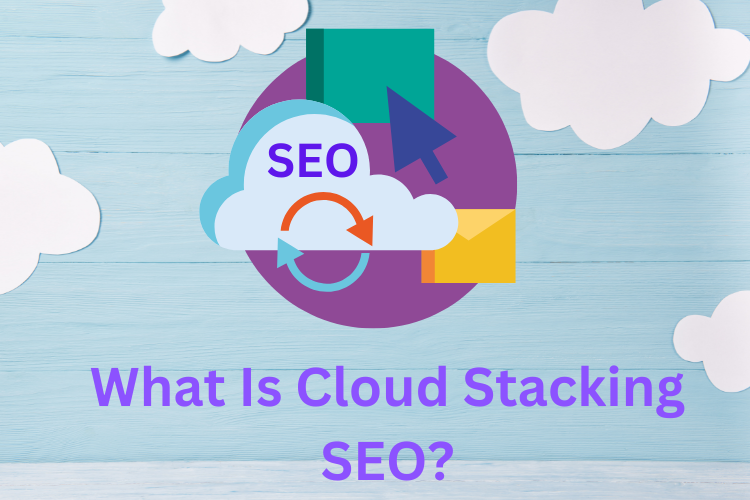In this article, we will talk about what cloud stacking SEO is, its benefits, and how to implement it on our website to increase the chances of ranking higher on Google.
What is Cloud Stacking SEO?
Cloud Stacking SEO is a method that uses online resources (the cloud) to make a website more visible and successful on search engines like Google.
By leveraging these cloud-based tools, it helps the website get more visitors and higher rankings in search results. This can be done by creating cloud-based properties, optimizing them for SEO, and interlinking them with your website.
Cloud stacking SEO can help to improve your website’s ranking in search engines, increase traffic to your website, and boost your website’s authority.

Benefits of Cloud Stacking SEO:
There are a number of benefits to using cloud stacking SEO, let’s understand a few of them.
Increased website speed and performance:
Cloud-based hosting platforms offer high scalability and performance, which can help to improve your website’s loading speed and performance.
This is important for SEO because search engines like Google factor in loading speed as a ranking factor.
Improved website security:
Cloud-based hosting platforms offer robust security features, which can help to protect your website from hackers and other security threats.
This is important for SEO because search engines like Google factor in security as a ranking factor.

Scalability and reliability:
Cloud-based hosting platforms are highly scalable and reliable, which means that your website can handle even the most demanding traffic spikes.
This is important for SEO because search engines like Google factor in scalability and reliability as ranking factors.
Increased website authority:
Cloud stacking SEO can help to increase your website’s authority in the eyes of search engines.
This is because cloud-based properties are often seen as more credible and trustworthy than traditional websites.
Improved user experience:
Cloud-based properties can offer a better user experience than traditional websites.
This is because they are often more responsive and easier to navigate.
A better user experience can lead to increased website traffic and improved SEO performance.
Should You Do Cloud Stacking SEO?
Whether or not you should do cloud stacking SEO depends on a number of factors, including your website’s goals, your budget, and your level of technical expertise.
Cloud stacking SEO can be a very effective way to improve a website’s SEO performance. However, it is important to note that cloud stacking SEO is not a silver bullet.
It is still important to implement other SEO techniques, such as keyword research, on-page optimization, and off-page optimization.
If you are considering using cloud stacking SEO, there are a few things you should keep in mind:
It can be expensive.
Cloud stacking SEO can be more expensive than traditional SEO techniques.
This is because you will need to pay for the cost of cloud hosting and the cost of any SEO tools you use.
It can be complex.
Cloud stacking SEO can be more complex than traditional SEO techniques.
This is because you will need to understand how to use cloud platforms and how to optimize your cloud-based properties for SEO.
It is not a guarantee of success.
Cloud stacking SEO is not a guarantee of success.
There are a number of factors that can affect the effectiveness of cloud stacking SEO, such as the quality of your content, the competition in your niche, and the algorithm changes made by search engines.
Risk vs. Reward:
Cloud stacking involves creating a network of interconnected web properties, which can be seen as a link scheme.
The risk of penalties from search engines should be weighed against the potential benefits.
Long-term Strategy:
Building a solid SEO strategy requires a focus on high-quality content, user experience, and natural link-building.
Relying solely on cloud stacking might not be a sustainable long-term approach.
If you are willing to invest the time and money, cloud stacking SEO can be a very effective way to improve your website’s SEO performance.
However, it is important to weigh the pros and cons carefully before deciding whether or not to use this technique.

Best Practices of Cloud Stacking SEO
Here are some best practices for cloud stacking SEO:
Choose the right cloud platforms.
When choosing cloud platforms for cloud stacking SEO, it is important to consider the following factors:
- The kind of content you will be hosting.
- The amount of traffic you want to get.
- Your budget.
Create cloud-based properties.
Once you have chosen your cloud platforms, you need to create cloud-based properties.
These can be anything from simple HTML pages to complex applications.
Optimize your cloud-based properties for SEO.
This includes optimizing the content, the code, and the metadata for your cloud-based properties.
Interlink your cloud-based properties.
This means creating links between your cloud-based properties.
This will help to improve the overall SEO (search engine optimization) of your website.
Use a variety of cloud platforms.
Using a variety of cloud platforms can help to distribute your website’s content across multiple servers, which can improve its performance and availability.
Use high-quality cloud hosting providers.
This will ensure that your cloud-based properties are hosted on reliable and secure servers.
Use a cloud content delivery network (CDN).
A CDN can help to improve the loading speed of your cloud-based properties by caching them on servers that are located closer to your website’s visitors.
Use SEO tools.
There are a number of SEO tools available that can help you to optimize your cloud-based properties

How to Implement Cloud Stacking SEO?
Cloud stacking SEO is a technique that involves creating multiple cloud-based properties and interlinking them to boost the visibility of a target website in search engines.
Here are the steps on how to implement cloud stacking SEO:
Choose the right cloud platforms.
There are many different cloud platforms available, so you need to choose the ones that are right for your needs.
Some factors to consider include the platform’s domain authority, its pricing, and its features.
Create cloud-based properties.
Once you have chosen your cloud platforms, you need to create cloud-based properties on each platform.
These properties can be anything from simple HTML pages to more complex applications.
Interlink the cloud-based properties.
Once you have created your cloud-based properties, you need to interlink them.
This means creating links between the properties on different cloud platforms.
Optimize the cloud-based properties for SEO.
Once you have interlinked the cloud-based properties, you need to optimize them for SEO.
This means optimizing the content, the titles, and the meta descriptions of the properties.

Promote the cloud-based properties.
Once you have optimized the cloud-based properties, you need to promote them.
This means submitting them to search engines and social media platforms.
how to get Cloud Stacking dofollow Backlinks
Cloud stacking SEO involves utilizing cloud-based resources to enhance a website’s SEO performance.
One way to do this is to get cloud stacking dofollow backlinks. These are links that point to your website from cloud-based properties.
There are a few ways to get cloud stacking dofollow backlinks:
Create cloud-based properties and optimize them for SEO.
This includes using relevant keywords throughout your content, creating high-quality content, and promoting your content on social media.
Guest blog on cloud-based properties.
This is a smart way to get links from good websites. When you write a guest blog, remember to add a link to your own website in your author bio.

Contribute to cloud-based forums and discussion boards.
This is another great way to get backlinks from high-quality websites.
When you contribute to forums and discussion boards, be sure to include a link back to your own website in your signature.
Submit your website to cloud-based directories.
There are a number of cloud-based directories that allow you to submit your website for free.
When you list your website in a directory, don’t forget to include a link back to your website within the listing.
Doing this can bring more people to visit your website and make it easier for others to find your website in Google.
It is important to note that not all cloud-based properties will give you dofollow backlinks.
Some properties only allow nofollow backlinks.
When you are creating cloud-based properties or guest blogging on cloud-based properties, be sure to check the backlink policy before you start creating content.
Summary:
To sum up, Cloud Stacking SEO is a helpful SEO strategy to make your website rank better on Google.
Once you understand what Cloud Stacking SEO is and how to use it, as explained in the article above, you can apply it to your site and attract more visitors from search engines.
When you use cloud-based tools and make your content better, more people will see your website.
So, try Cloud Stacking SEO in your online marketing, and you will see your website grow and get more attention on the internet.
